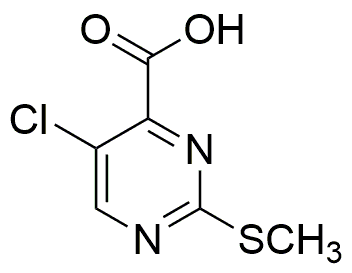5-Chloro-2-(methylthio)pyrimidine-4-carboxylic acid is widely utilized in research focused on:
- Agricultural Chemistry: This compound serves as a key intermediate in the synthesis of various agrochemicals, particularly herbicides. Its ability to inhibit specific plant enzymes makes it valuable for developing effective weed control solutions.
- Pharmaceutical Development: It is used in the synthesis of pharmaceuticals, especially in creating compounds that target specific biological pathways. Researchers appreciate its role in developing potential treatments for various diseases.
- Biochemical Research: The compound is utilized in studies exploring metabolic pathways and enzyme interactions. Its unique structure allows scientists to investigate the effects of sulfur-containing compounds in biological systems.
- Material Science: This chemical is explored in the development of novel materials, including polymers and coatings. Its properties can enhance the performance and durability of materials used in various applications.
- Analytical Chemistry: It is employed as a reference standard in analytical methods, aiding in the identification and quantification of similar compounds in complex mixtures, which is crucial for quality control in various industries.
Información general
Propiedades
Seguridad y normativas
Aplicaciones
5-Chloro-2-(methylthio)pyrimidine-4-carboxylic acid is widely utilized in research focused on:
- Agricultural Chemistry: This compound serves as a key intermediate in the synthesis of various agrochemicals, particularly herbicides. Its ability to inhibit specific plant enzymes makes it valuable for developing effective weed control solutions.
- Pharmaceutical Development: It is used in the synthesis of pharmaceuticals, especially in creating compounds that target specific biological pathways. Researchers appreciate its role in developing potential treatments for various diseases.
- Biochemical Research: The compound is utilized in studies exploring metabolic pathways and enzyme interactions. Its unique structure allows scientists to investigate the effects of sulfur-containing compounds in biological systems.
- Material Science: This chemical is explored in the development of novel materials, including polymers and coatings. Its properties can enhance the performance and durability of materials used in various applications.
- Analytical Chemistry: It is employed as a reference standard in analytical methods, aiding in the identification and quantification of similar compounds in complex mixtures, which is crucial for quality control in various industries.
Documentos
Hojas de datos de seguridad (HDS)
La SDS proporciona información de seguridad completa sobre la manipulación, el almacenamiento y la eliminación del producto.
Especificación del producto (PS)
La PS proporciona un desglose completo de las propiedades del producto, incluida la composición química, el estado físico, la pureza y los requisitos de almacenamiento. También detalla los rangos de calidad aceptables y las aplicaciones previstas del producto.
Certificados de análisis (COA)
Busque certificados de análisis (COA) ingresando el número de lote del producto. Los números de lote y de partida se pueden encontrar en la etiqueta de un producto después de las palabras "Lote" o "Lote".
Número de catálogo
Número de lote/lote
Certificados de origen (COO)
Este certificado de origen confirma el país en el que se fabricó el producto y también detalla los materiales y componentes utilizados en él y si se deriva de fuentes naturales, sintéticas u otras fuentes específicas. Este certificado puede ser necesario para cumplir con las normativas aduaneras, comerciales y regulatorias.
Número de catálogo
Número de lote/lote
Hojas de datos de seguridad (HDS)
La SDS proporciona información de seguridad completa sobre la manipulación, el almacenamiento y la eliminación del producto.
DownloadEspecificación del producto (PS)
La PS proporciona un desglose completo de las propiedades del producto, incluida la composición química, el estado físico, la pureza y los requisitos de almacenamiento. También detalla los rangos de calidad aceptables y las aplicaciones previstas del producto.
DownloadCertificados de análisis (COA)
Busque certificados de análisis (COA) ingresando el número de lote del producto. Los números de lote y de partida se pueden encontrar en la etiqueta de un producto después de las palabras "Lote" o "Lote".
Número de catálogo
Número de lote/lote
Certificados de origen (COO)
Este certificado de origen confirma el país en el que se fabricó el producto y también detalla los materiales y componentes utilizados en él y si se deriva de fuentes naturales, sintéticas u otras fuentes específicas. Este certificado puede ser necesario para cumplir con las normativas aduaneras, comerciales y regulatorias.


